Guard dogs are trained or bred to protect their owners from dangers. It can be an intruder, predator, or other kind of threat. Unlike watchdogs who only alert the owners, guard dogs are trained to act on the situation. This means, neutralising the threat. So, if you are looking for the best guard dogs in the UK, you have found the perfect article.
There are ample guard dog breeds that are suitable for protective purposes. But, it’s important for dog owners to make sure that they consider their preferences and requirements before petting one. Also, different dog breeds have different behaviour and personality so, becomes extremely crucial for dog owners to consider these prospects before making a decision. So, let’s dive into different prospects.
Best Guard Dogs
A good guard dog is not only categorised based on the breed but, also on training, temperament, socialisation and other such factors. In addition, the guard dog should also be able to distinguish between friend and enemy. Like this, there are other prospects which influence the choice of the best guard dog.
But, before we glide into those details, it is important to know why they are needed in the first place. This helps to understand the intent behind getting a guard dog.
Guard dogs – why do dog owners need them?
In general, dog owners get a guard dog to feel safe. But, there are several other reasons why dog owners pet a guard dog. Here are some of the prominent reasons why dog owners need guard dogs:
- Simple desire – some dog owners simply have the desire to pet a guard dog. These dog owners are experienced and based on their hobby or lifestyle, they prefer to have a new experience.
- Specific purpose – farmers, police, or other such individuals might need a guard dog to meet a specific purpose. For instance, a farmer needs a guard dog to protect the farm from other animals, or possibly hunters, or thieves. Likewise, police may need a guard dog to investigate different matters while ensuring their own safety.
- Security and companionship – guard dogs are known to form a nice bond with their dog owners. They show unconditional love, loyalty, and affection towards their owner.
- Protection of family – some dog owners have to get a dog guard to protect their family from different types of threats. They bark or attack intruders or other animals who pose a threat to the family members of the dog owner.
Legal aspects of owning a guard dog
These are some of the common reasons why dog owners need a guard dog. Your reason might be different but, you should make sure that you know the legal aspects of owning a guard dog. Yes, there are some significant rules related to this prospect. Here are they:
This act highlights the regulations to owning the guard dogs and, using them. Here are some of the key points mentioned in these regulations:
- There must be a handler present near the dog all the time. The handler must control the dog when they are not secured.
- A clear warning sign needs to be kept at the entrance to inform the visitors regarding the presence of the guard dog.
License for guard dogs’ kennels
- If the dogs are kept at the kennels, a license needs to be acquired from the local authority
- The license comes with certain conditions and usually lasts for twelve months
Also, the breach of this act is considered a criminal offence. So, make sure you follow the rules.
#2. Common Criminal Law and Animals Act 1971
- Apart from the specific legislation, common law principles and the Animals Act 1971 apply to guard dogs.
- These laws protect dogs, the dog owners and the third parties involved.
Now, apart from these two acts, there are some other legal aspects which dog owners cannot ignore. Below are some of the legal prospects that are crucial to abide by:
- Animal Welfare Act 2006 – this act refers to basic welfare prospects like – providing enough food and water, suitable shelter, mental stimulation, regular health care and companionship.
- Dangerous Dogs Act – there are many dogs which are considered dangerous and not allowed for dog owners to own in the UK. Owning these dogs can lead to legal troubles so, as a dog owner you need to make sure that you don’t get a dangerous dog as a guard dog.
- Control of Dogs Order 1992 – this legal prospect highlights that every dog should wear a collar with the owner’s name and address on it.
- Microchipping of dogs’ regulations 2015 – it is mandatory for every dog owner to have their furry friend microchipped. The details need to be kept updated to make sure that lost dogs are united back with their respective owners.
- Dogs Act 1953 – this act is for the protection of other animals that reside near the farm or any other agricultural land.
- Roads Traffic Act 1998 – your dog should not cause accidents or create chaos in public. Dog owners need to contain their dogs’ behaviour to minimise the risk of such instances.
Best Guard Dogs for Protection
You saw the reasons why guard dogs are needed. Based on those prospects, and other parameters, you will find the best guard dog breeds in this section. I have profiled different breeds that are considered good guarding dogs.
#1. German Shepherd Guard Dog
A German Shepherd is known for tailored protection and companionship. It is bred and trained to safeguard owners’, property, or livestock from predators, or other threats. Dog owners in the UK prefer having a German Shepherd as their guard dog ahead of the other dogs.
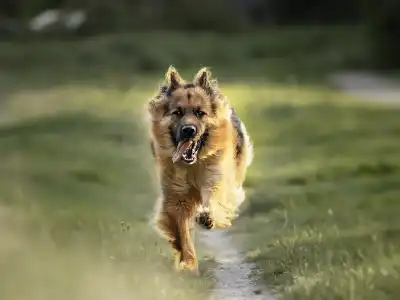
- Size – a male German shepherd guard dog stands about 24-26 inches at the shoulder, 36-42 inches long and weighs 65-90 pounds. A female German shepherd guard dog stands 22-24 inches at the shoulder, 36-42 inches long, and weighs roughly about 50-70 pounds.
- Appearance – a German shepherd guard dog looks like a medium to large wolf-like dog with a long muzzle. They have triangular ears and a black and tan coat. It has a thick undercoat and coarse guard hairs which shed rapidly. It stands higher in front than in the rear. This makes the appearance slanted.
- Diet – the diet requirements of a German Shepherd guard dog is a high-protein, low-fat diet which consists of animal muscle meat, vegetables, fruits, and best dog food. They need to be fed twice a day in small portions to avoid bloating and digestive issues. The diet served should not include ingredients like grapes, raisins, and chocolate.
- Energy level – you can expect a medium to high energy level range in a German Shepherd guard dog. They require intense exercise i.e. at least an hour of lively exercises like playing, training, or simply running. Also, the training or exercises should provide mental stimulation and challenges to maintain their cognitive intelligence.
- Temperament – German Shepherd dogs are loyal, courageous, obedient, protective, and intelligent dogs. It forms a strong bond with the owner and will defend them in any condition. In addition, it plays with family members of the owner and is joyful.
#2. Bullmastiff
This guard dog combines loyalty, strength, and protective instincts. They are good at guarding large properties and are known for their presence. So, one can expect proper protection for themselves and their property.
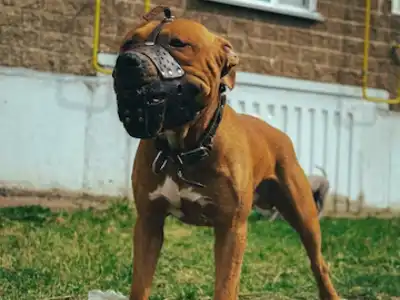
- Size – the male Bullmastiff guard dog stands at 25-27 inches at the shoulder and weighs 110-130 pounds. A female Bullmastiff guard dog stands 24 to 26 inches at the shoulder and weighs roughly between 100-120 pounds.
- Appearance – a large muscular dog that has a short muzzle, broad head, and a black face mask. The coat is short, dense, and of different colours, like red, fawn, or brindle. Further, the neck of a Bullmastiff is strong, and they have a deep chest and a long tail.
- Diet – the diet of a Bullmastiff needs to include balanced nutrition. It should provide enough energy and must be fed twice a day to avoid the risk of obesity. The meal should not include any toxic substances that could harm the dog.
- Energy level – the energy levels of a Bullmastiff are medium to high. They require moderate exercise to maintain healthy cognitive function and prevent boredom. If you appoint one of the family members to conduct half an hour training session or a simple walking or running exercise then it will be fine.
- Temperament – the confidence level of Bullmastiffs is high and they are fearless, loyal, and protective of their owners.
#3. Doberman Pinscher
A Doberman guard dog is well-trained to safeguard the owner and their property from intruders, predators, or other such threats. Here is what their profile looks like,
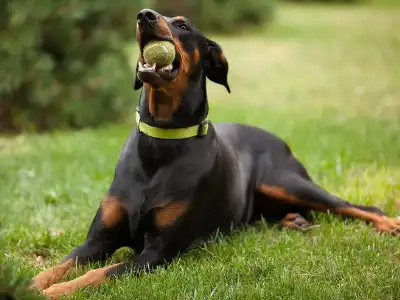
- Size – male Doberman Pinscher stands about 24 – 28 inches at the shoulder and weighs about 65 -100 pounds. Whereas, a female Doberman pinscher guard dog stands 22 to 26 inches at the shoulder and weighs 50-80 pounds.
- Appearance – Doberman Pinscher can be considered a medium-large dog. They are deep-chested and strong by nature. Their coat is smooth and short. You will see blue, black, fawn, or red colour coat with rust markings on the legs, chest, muzzle, and eyebrows.
- Diet – like German shepherds and Bullmastiffs, Doberman pinschers also need highly nutritious meals to maintain proper health. One can feed them such meals twice a day in moderate portions to stop obesity and overeating.
- Energy level – a Doberman pinscher guard dog has high energy levels. Dog owners will have to make sure they receive enough exercise to keep up with their energy levels to maintain proper physique and mental health.
- Temperament – Doberman guard dog is loyal, intelligent, fearless, and protective of its owners. But, to make sure it follows the instructions of the owner, they need early training. Their behaviour against strangers will be aggressive and will only follow their owners’ instructions.
#4. Belgian Malinois
If you seek strong bonding with a guard dog then, Belgian Malinois is the one you are looking for. They are known to establish good bonds with their owners while safeguarding them and their properties.
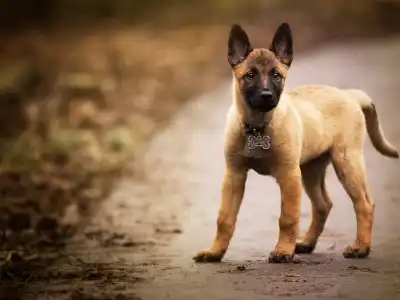
- Size – this guard dog stands 24 to 28 inches at the shoulder and weighs between 65-100 pounds on average. A female Belgian Malinois stands 22 to 26 inches at the shoulder and weighs roughly weights within a range of 50 to 80 pounds.
- Appearance – Belgian Malinois is a medium-sized dog with a deep chest. They are strong and have a short and smooth coat which comes in red, black, blue, or fawn. You will also notice some rust markings on their chest, eyebrows, cheeks, chest, and muzzle.
- Diet – the meal for a Belgian Malinois should include high-quality nutrition ingredients. The meals should be fed twice a day to prevent overeating or obesity issues.
- Energy level – this guard dog will need plenty of physical and mental stimulation. You’ll have to conduct exercise or training sessions for about an hour to meet their requirement.
- Temperament – they are protective, loyal, intelligent, and courageous. They protect their owner from any threat and also share a strong bond with them.
#5. Rhodesian ridgeback
Rhodesian ridgeback guard dogs are athletic. Like other guard dogs, they will be protective of their owners’ property and neutralise possible threats as well.
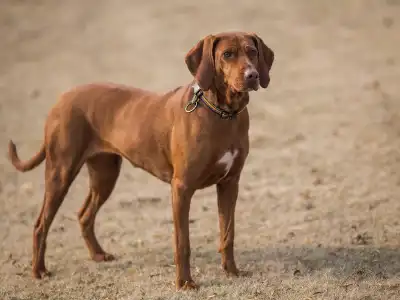
- Size – a male Rhodesian ridgeback guard dog stands 25-27 inches at the shoulder and weighs 85-90 pounds whereas the female Rhodesian ridgeback guard dog stands at 24-26 inches and weighs roughly 70-75.
- Appearance – Rhodesian ridgeback appears to be a medium-large, athletic dog with a variety of ridges of hair alongside the back. The coat of this guard dog will come in different shades of wheaten, ranging from light to red. Their muzzle is long, they have floppy ears, black noses, and amber or brown eyes along with a long tail.
- Diet – like other guard dogs, the diet of Rhodesian ridgeback should contain proper nutrition to maintain proper health. It should be fed twice a day to minimise the risk of overeating or obesity.
- Energy level – Rhodesian ridgeback guard dogs have high energy levels. They will need plenty of exercise to maintain physical and mental health. Owners might have to conduct exercises or training sessions that will at least last an hour.
- Temperament – a Rhodesian ridgeback guard dog is loyal, independent, protective and courageous. Like other guard dogs, they will form a strong bond with the owner and protect them no matter what. They will obey dog owners’ commands and act accordingly.
Perks of Having a Guard Dog
Regardless of the guard dog that a dog owner pets, there are ample benefits that they leverage. The benefits are even more if they develop a strong bond with the guard dog they pet. The following are some of the prominent perks of having a guard dog:
#1. House safety
The presence of a guard dog helps keep the burglars away so, the house remains secure. This is because they bark immediately once they smell or sense the presence of another individual apart from its owner or other family members.
Further, this protection is not subject to dog owners’ presence in the house. Meaning, they are trained to protect the property in the absence of the dog owner.
#2. Protects owners and family members
One of the main reasons why dog owners get a guard dog is to ensure their safety and also protect their family members. Guard dogs provide that as their hearing and sensing capability is good. They will alert the owners and their members.
#3. Quick responder and selfless protector
A guard dog will respond to any potential threat and neutralise it. They are trained to protect the owners and also to obey their instructions at all costs. This means regardless of their physical state or capacity they will protect their owners.
#4. Ideal companion for seniors and handicapped individuals
Senior citizens or handicapped individuals are vulnerable and need assistance. A guard dog can be an ideal companion for such people, especially from the protection point of view. They lack the strength to defend themselves and having a guard dog by their side provides
Drawbacks of having a guard dog
The idea of having a guard dog is tempting but, there are some disadvantages as well. As a responsible dog owner, you should analyse the drawbacks as it helps in deciding whether you can manage to own a guard dog.
#1. Aggressive behaviour
A guard dog goes through extensive training and because they are trained to protect their owner and their property at all costs so, the aggression will be persistent. As a dog owner, you’ll have to face aggressive behaviour more often.
#2. Liability and legal concerns
As mentioned earlier, there are plenty of legal prospects involved when it comes to owning a guard dog. Even if you manage to follow the rules, there is always a risk of lawsuit as many people will not feel comfortable with the presence of a guard dog in proximity.
#3. Social challenges
Dog walking with a guard dog becomes challenging. For instance, if you go out for a walk and if a person approaches you the dog might comprehend it as a threat. It will be difficult to contain them and this issue will remain persistent unless they receive extensive socialising experience.
#4. High Maintenance
Guard dogs will need highly nutritional food and regular exercise. To provide nutritious food and train dogs regularly, dog owners have to spend a significant amount of money. Not to mention, the regular vet visits also pile up the expenses.
Guard Dog Training
A guard dog receives professional training before a dog owner pets them in the UK. However, it’s necessary to continue training after you get a guard dog at home. This helps maintain their shape and also with the transition. By transition I mean they will get used to the terrain and environment as it will be theirs to protect. Below are some guard dog training tips to consider:
#1. Obedience training
You’ll have to make sure that your guard follows your command otherwise, based on their instincts, they will attempt to neutralise threats even if they are your friends or family members. If they do not follow your command then your friends or family members are likely to get injured or frightened by their barking. Obedience training is important as it establishes trust between the guard dog and you.
#2. Socialisation
Your guard dog might follow your commands but, it is important that they get to meet different dogs and people. They need to know that not every individual is a threat. This helps in containing the sudden burst of aggression when they see strangers around the house or while walking.
#3. Teach to bark without commands
The idea behind having a guard dog is to get alerts on suspicious activity through barking. So, you need to train them to bark without waiting to receive your commands. Otherwise, you’ll not see them act on the potential threats that you might face. Which is the main purpose of owning a guard dog.
However, it is also important to associate commands to make them stop. The reason is simple, if you are expecting guests at home in the morning, noon, or evening, your furry friend is likely to bark once, it sees them approaching your doorsteps. Now, until you command them to stop, they will continue to do so. This is not only disturbing for the visitors but, also for your neighbours.
#4. Regular exercises
Guard dogs need physical and mental stimulation regularly. You need to conduct regular exercise or training sessions to ensure they remain in shape. The training or exercising sessions also help in improving their cognitive capacity and they can function better.
#5. Familiarise the dog with the terrain
Once you are done with regular training, you need to take your dog for a stroll around the house and help them get familiar with the terrain. This will make them realise which areas need to be protected. You also need to associate phrases like guard or watch while showing them the perimeter. Doing this will make dogs bark when they identify potential threats or see substantial disturbance.
#6. Provide food treats, or toys as rewards
Guard dogs need to be encouraged from time to time. So, when they obey your command or guard your terrain, provide them with food treats, toys, or other items to acknowledge their commitment. This will encourage them to continue guarding your house, terrain, or other property with more liveliness.
Based on your experience of owning a pet dog, you can use different training tactics to work with your guard dog. But, if you are a newbie then, you may require additional assistance. Consult with a professional dog trainer to ensure a smooth transition. Yes, it will be costly but, it is necessary to avoid any legal issues and establish a proper bond with the dog.
FAQs for Best Guard Dogs
How much is a guard dog worth in the UK?
A guard or protective dog is costly. Based on the dog breed, and the training, mental stability, or obedience, one can expect to pay at least £2500. However, this is just the beginning price. Different guard dogs have different abilities and are trained differently. So, the prices can go well above like more than £75000. But, higher-priced guard dogs are trained extensively and have some astonishing benefits. So, as a dog lover, you need to identify your needs and get a guard dog without compromising the budget. It is possible if you consult with a professional dog trainer.
Which guard dog species are not allowed in the UK?
Based on the behaviour, and other characteristics the following guard dog species are not allowed in the UK – Pit Bull Terrier, Japanese tosa, Fila Brasileiro, and Dogo Argentino. These dogs are considered dangerous and are banned in the UK.
How will I know if I need a guard dog?
It is simple, if you are feeling unsafe in your house, or there is a surge in criminal offences nearby, you will get a feeling to get a guard dog (assuming you like dogs). Even if you have never petted a dog before, you know they are good companion and have the ability to protect people from threats like assault, robbery, or other incidents.
Who can benefit from having a guard dog?
Single women, people with physical limitations, senior citizens or individuals who reside alone will benefit from having a guard dog by their side. In addition, families who reside in areas susceptible to violence or crime will also benefit by having a guard dog around. In fact, one guard dog can change the dynamics of the neighbourhood and make it more secure considering there is a general acceptance by fellow residents.
Final Remarks on Best Guard Dog
Guard dogs help people feel secure and also, protect their properties. There are plenty of guar dogs out there and selecting one is tough, as it requires high investment. You don’t want to spend thousands of pounds blindly. As a responsible citizen and a dog owner, one needs to have a clear idea regarding the legal prospects before getting the best guard dog at home.
To avoid any issues, it’s best to consult with a professional dog trainer. They can guide you through the procedure of owning the dog, how to keep training them, and other necessary prospects. You can also connect with your fellow dog owners, especially the ones owning a guard dog and get some insights into challenges that come along.
Lastly, if you decide to get a guard dog, make sure that you keep training and improving the bond. There are certain challenges but, you’ll get used to them and deal with them efficiently. They are loyal, obedient and protective. If you have any concerns or queries, mention them in the comments. Our team will provide you with the solution.



